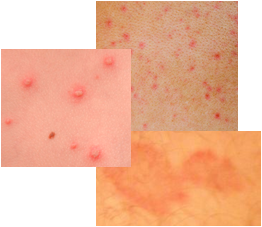Types of Problem Skin
Visit this
PICTURES OF RASHES PAGE
Problem skin can be divided into various categories. Determining which skin type your skin matches is an important step in proper and healthy skin care. For example, you do not want to pursue a skin care regiment or use skin care products for oily skin if you have dry skin. In addition, if you have sensitive skin, then you need to pay closer attention to the type of products being used on your skin to avoid possible allergic skin reactions.
Skin has its own set of characteristics that are very useful in the identification of the actual skin type. However, before examining the characteristics of problem skin, it would be useful to examine the properties of normal skin.
Normal Skin
The characteristics of an individual with a normal skin type are:
- skin texture is even, soft, smooth, and plump
- the skin is reasonably firm to the touch
- the skin has good elasticity
- no red or dark patches on the skin and the skin color is fairly even
- pores of the skin are small to medium in size
- blemishes are uncommon
- in general the skin neither feels too oily or too dry
- most quality skin care products do not irritate the skin
- overall the skin looks vibrant and healthy
Oily Skin
The first type of problem skin is oily skin. An individual with oily skin may have the following skin features:
- shiny or slippery skin appearance, especially on the forehead, nose, and chin (the T-zone)
- skin is course, overly firm, and thicker, beyond that of normal skin
- pores are large and visible
- pimples, blackheads, whiteheads, and other acne blemishes are present or frequently appear
- after washing, skin gets an oily build-up after only a couple of hours
- oily film on face is present after sleeping
- for women, make-up foundation only lasts a couple of hours
- flakiness around the nose area may exist due to dried excess oils
- oily skin is slow to develop discolorations such as freckles, fine lines, and wrinkles as the skin ages
- the skin tans easily
- hair is oily
Dry Skin
Opposite to oily skin, dry skin is another common type of skin. The various signs given below identify dry skin:
- flaking of the skin is common
- skin feels tight (especially after washing), looks dull, and is rough
- the skin may have red patches
- in more severe cases, this skin problem will cause cracks in and bleeding of the skin
- fine lines and wrinkles are evident
- skin generally has fine pores
- few acne blemishes are present
- the skin is often itchy
- hair is dry
For more information on dry skin, please visit the following link: dry skin care.
Combination Skin
Combination skin is a term used to described skin that can be both oily and dry at the same time. It is perhaps the most common type of problematic skin and looking for the following characteristics can identify it:
- the forehead, chin, and nose are oily (the T-zone area), but the cheeks and skin around the eyes can range from normal to dry
- in another manifestation of combination skin, the skin may be oily along the chin, jaw line, and temples, but dry or normal elsewhere
- skin pores are medium in size
- overall the skin appears normal and healthy, not including those small affected areas that are too oily or dry
Sensitive Problem Skin
Sensitive skin is very troublesome for many individuals. People with this skin type experience the following:
- sensitivity to cosmetics (especially those that are heavily scented)
- rashes or red blotchy patches may develop on the skin with exposure to applied pressure, wind, sun, or temperature changes
- certain skin care products also trigger rashes
- broken blood vessels and capillaries are evident under the surface of the skin
- this problem skin type usually has a fine texture
- skin has fine pores
Another element of sensitive skin has to do with sensitivity to the sun. People with this type of problem skin are generally more susceptible to sunburns. However, susceptibility to sunburns is not exclusive to individuals that have problem skin. Features such as skin color, hair color, and eye color can determine sun sensitivity.
If a person has:
- white or pale/milky skin, freckles, blond or red hair, blue or green eyes.
Then:
- the individual never tans and is more likely to be sunburned with the potential of painful swelling and skin blistering/peeling.
If a person has:
- white skin, blond hair, blue or green eyes.
Then:
- the individual is likely to be sunburned, but sometimes may tan.
If a person has:
- white skin or light brown or olive toned skin, dark hair, brown eyes.
Then:
- the individual is not usually sunburned, but instead usually tans.
If a person has:
- brown to dark skin, brown or black hair, brown eyes.
Then:
- the individual always tans and rarely is sunburned.
Regardless of whether you have problem skin or heightened skin sensitivity, the use of an appropriate sunscreen is highly recommended when in the sun.
Related oily skin information:
oily skin care | problem skin types | causes | basic treatments | natural treatments
